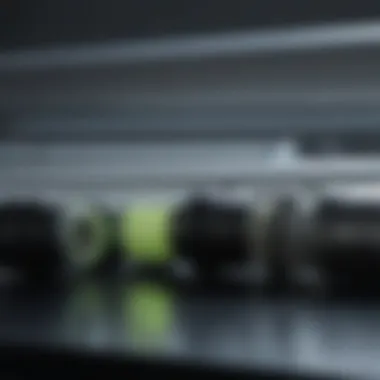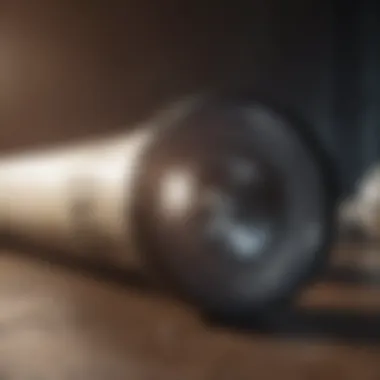Proper Disposal of Fluorescent Tubes: Guidelines and Considerations


Overview of the Topic
The disposal of fluorescent tubes poses significant environmental challenges. Understanding these challenges is critical for both individuals and organizations concerned with ecological preservation. Fluorescent tubes contain small amounts of mercury, a toxic element that can have serious repercussions on ecosystems if not disposed of correctly.
It is essential to realize that these products are commonplace in various settings, from homes to offices and educational institutions. As such, their disposal is not just a personal concern; it extends to community health and safety.
Current Status and Challenges
Currently, many areas lack enforced regulations regarding the disposal of fluorescent tubes. This oversight contributes to improper disposal, often leading to broken tubes ending up in landfills. This is problematic as the mercury can leach into the soil and waterways, adversely affecting wildlife and human health.
Some prevalent challenges include:
- Lack of awareness: Many people are unaware of the hazards associated with fluorescent tubes.
- Inconvenient disposal options: The absence of accessible recycling centers dissuades proper disposal practices.
- Cost implications: Sometimes, recycling services may come with fees, discouraging environmentally-friendly choices.
Sustainable Solutions
Addressing the issues surrounding fluorescent tube disposal requires collective action and viable solutions. Sustainable practices play a pivotal role in mitigating environmental risks. Solutions include:
- Public education campaigns: Raising awareness can significantly change disposal habits.
- Establishment of recycling programs: Cities can set up designated drop-off locations specifically for fluorescent tubes.
- Transition to LED lighting: Encouraging the shift to LED bulbs, which do not contain mercury, reduces dependency on fluorescent tubes.
Cities like San Francisco have implemented successful recycling programs that not only provide easy disposal options but also educate residents about the importance of safe waste management.
Impact and Importance
The impact of improper fluorescent tube disposal is profound. Mercury contamination poses a threat to aquatic life and can enter the food chain, leading to greater ecological damage. Additionally, communities that disregard proper disposal will likely face increased health risks related to pollution exposure.
Emphasizing the importance of proper disposal practices ensures a healthier environment for future generations. Each responsible action taken today can contribute to a sustainable future. As conservationists and environmentalists, adopting and advocating for safe practices leads to meaningful change.
"Responsible disposal of fluorescent tubes is a matter of collective duty, not merely individual choice."
Foreword to Fluorescent Tubes
Fluorescent tubes serve a pivotal role in modern lighting applications. Their importance cannot be understated, as they balance efficiency, longevity, and effective illumination. Understanding how these lights operate and their respective uses allows individuals and organizations to make informed decisions regarding their installation and eventual disposal. The topic of fluorescent tubes encompasses not only their technical aspects but also their environmental implications, which become vital when considering disposal methods.
The disposal of fluorescent tubes demands special attention. This need arises primarily due to their unique composition, which includes materials that can be harmful to the environment if not handled correctly. This article aims to provide a thorough investigation into the guidelines and considerations relevant to the proper disposal of these lighting solutions.
Understanding Fluorescent Technology
Fluorescent technology operates through a fascinating process. When electrical current passes through the gas inside the tube, it creates ultraviolet light. This light interacts with the fluorescent coating on the inner surface of the tube, converting it into visible light. This technology brings forth numerous benefits, including increased energy efficiency compared to traditional incandescent bulbs.
However, the advantage of longer lifespan and lower energy consumption comes with a caveat. The presence of mercury in these tubes complicates their disposal. Mercury is a toxic substance that can pose significant environmental risks if released. Recognizing this component is essential for anyone involved in the use of fluorescent tubes, especially when the time comes for disposal.
Common Uses of Fluorescent Tubes
Fluorescent tubes are versatile and find applications across various environments. They are widely used in commercial spaces, such as retail stores and offices, to provide bright and efficient lighting. Moreover, educational institutions often rely on these tubes for classroom and laboratory settings due to their effective lighting properties.
In residential settings, fluorescent tubes can be found in garages, basements, and kitchens, where bright light is necessary. Their popularity stems from their efficiency, cost-effectiveness, and even distribution of light.
Hazards Associated with Fluorescent Tubes


Fluorescent tubes serve a vital role in modern lighting, yet they come with inherent risks that need careful management. The hazards associated with these tubes are paramount in understanding their disposal. Proper awareness and actions can prevent environmental harm and safety risks. Factors like breakage risks and mercury content must be taken into account. They underscore the necessity for responsible disposal practices and underscore community and individual responsibilities.
Breakage Risks
Breakage of fluorescent tubes is a common concern and can lead to dangerous situations. Fluorescent tubes are made from glass which can shatter easily if dropped or mishandled. When breakage occurs, it can create sharp shards that pose physical injury risks. Moreover, there is potential for the release of harmful substances. To mitigate these risks, it's crucial to follow safe handling procedures.
- Use caution when moving or replacing tubes.
- Store tubes in protective packaging until disposal.
- Employ proper cleanup procedures if breakage occurs, using gloves and protective eyewear.
Taking these precautions ensures safety for the handler and bystanders alike.
Mercury Content and Environmental Impact
A critical hazard associated with fluorescent tubes is their mercury content. Mercury is a toxic metal that can have harmful effects on health and the environment. When fluorescent tubes are disposed of improperly, mercury can leach into soil and water sources, causing contamination.
It is estimated that a single fluorescent tube contains about 3 to 4 milligrams of mercury, which is enough to pollute a cubic meter of water.
Proper disposal or recycling is essential to prevent mercury exposure to ecosystems and human health.
- Local regulations often dictate the disposal methods for fluorescent tubes to minimize environmental impact.
- Recycling programs can safely handle the hazardous materials and reduce landfill waste.
It is crucial to be informed about these hazards to ensure responsible usage and disposal of fluorescent tubes.
Can You Throw Away Fluorescent Tubes?
The question of whether one can simply throw away fluorescent tubes is complex and deserves careful consideration. While it may seem tempting to dispose of these items as regular waste, doing so can jeopardize environmental safety and human health. Fluorescent tubes contain materials that are not only hazardous but also require specific disposal methods to prevent potential damage to the ecosystem. Recognizing these elements is crucial for responsible waste management and fosters a culture of environmental stewardship.
Local Regulations on Disposal
Local regulations often dictate how fluorescent tubes must be disposed of. These regulations vary by region, reflecting the unique environmental concerns and policies of each community. In many areas, it is illegal to dispose of fluorescent tubes in standard trash due to their mercury content. Mercury is toxic and can contaminate soil and water if released into the environment. Thus, residents need to familiarize themselves with local disposal laws to ensure compliance and avoid legal repercussions.
For precise guidance, it's advisable to visit local government websites or contact waste management facilities. Many municipalities provide drop-off sites where residents can deliver used fluorescent tubes safely. This creates opportunities for proper recycling and minimizes environmental risks. Moreover, some retailers offer take-back programs, allowing customers to return old tubes when purchasing new ones.
"Understanding local disposal regulations is essential for anyone dealing with fluorescent tubes."
General Guidelines for Disposal
When it comes to the general disposal of fluorescent tubes, certain best practices should always be followed:
- Handle with Care: Due to their glass construction, fluorescent tubes can break easily. Always transport them upright and in a secure container to prevent accidents.
- Educate Others: Inform family, friends, and colleagues about the proper disposal methods to promote collective responsibility towards fluorescent waste.
- Use Hazardous Waste Facilities: Many communities have designated hazardous waste days where residents can bring toxic items, including fluorescent tubes, for safe disposal.
- Seek Recycling Solutions: Recycling these tubes is a more sustainable option. Some facilities specialize in processing them, ensuring that hazardous materials are managed appropriately.
- Stay Updated: Regulations may change, so it's important to remain informed about the latest guidelines regarding fluorescent disposal.
Best Practices for Handling and Disposal
Understanding the best practices for handling and disposal of fluorescent tubes is crucial in preventing harm to both individuals and the environment. Fluorescent tubes contain hazardous materials, primarily mercury, which necessitates careful management from the point of use to disposal. Adhering to safe practices minimizes risks associated with breakage, exposure, and environmental pollution. These practices enhance the overall safety of both users and the communities in which they reside. By promoting responsible actions, individuals contribute to a more significant conservation effort on a larger scale.
Safe Handling Procedures
Safe handling of fluorescent tubes begins with proper awareness and education. It is important to handle these tubes gently, avoiding excessive force that could lead to breakage. When transporting or storing fluorescent tubes, always ensure they are upright and secured to prevent any tipping over or crushing. If a tube does break, it is crucial to avoid direct contact with the skin. The recommended immediate action includes carefully collecting the parts using a damp cloth and placing them in a sealed plastic bag.
In addition, consider the following tips for safe handling:


- Always check the local guidelines for handling fluorescent tubes to stay informed about the best methods specific to your area.
- Store tubes in a designated area that is well-ventilated and away from the reach of children and pets.
- Mark storage areas clearly to indicate the presence of hazardous materials.
These practices reduce the likelihood of accidental injuries and health risks associated with exposure to harmful substances.
Using Protective Equipment
The use of protective equipment is essential when handling fluorescent tubes, regardless of the context. Wearing gloves, ideally made from rubber or latex, reduces the risk of skin contact with any materials that may leak from broken tubes. Eye protection, such as goggles, is also recommended in case of unexpected incidents, which could lead to glass shards causing injury.
Additionally, respirators may be beneficial when working with larger quantities of fluorescent tubes, particularly in enclosed areas. Proper equipment includes:
- Heavy-duty gloves to provide a barrier against contamination.
- Safety goggles to prevent eye injuries from glass or mercury exposure.
- Dust masks or respirators to avoid inhalation of fine particles.
Using protective equipment not only safeguards the handler’s health but also fosters an overall culture of safety in environments where fluorescent tubes are used or stored.
Important: Always review local regulations regarding personal protective equipment to ensure compliance.
This proactive approach to safety can drastically reduce risks, making fluorescent tube handling and disposal more responsible and sustainable.
Recycling Options for Fluorescent Tubes
Recycling fluorescent tubes is a vital step in ensuring sustainable waste management practices. Unlike regular glass, fluorescent tubes contain materials that can be hazardous to the environment if not disposed of properly. Recycling these tubes can prevent chemicals, especially mercury, from contaminating landfills and waterways. It also allows for the recovery of valuable materials, which can then be reused in new products. This section explores how to find recycling facilities and the benefits associated with recycling fluorescent tubes.
Finding Recycling Facilities
To recycle fluorescent tubes, the first step is to locate recycling facilities in your area. Many communities have specific regulations regarding the disposal of hazardous waste, including fluorescent tubes. It’s crucial to know where you can safely drop them off or if there is a scheduled collection event dedicated to hazardous materials.
Here are some helpful ways to find recycling facilities:
- Check Local Government Websites: Most local governments have information on how to dispose of hazardous waste. Look for services specific to your area, as facilities can vary significantly from one region to another.
- Contact Local Waste Management Agencies: These agencies often have details about special programs for recycling fluorescent tubes. Calling them directly can yield precise information.
- Big Retail Stores: Certain retailers, like Home Depot or IKEA, may offer recycling programs for fluorescent tubes and other hazardous materials. Confirm if they accept such items before visiting.
"Recycling not only protects the environment but also promotes a circular economy, reducing the need for new resources."
Benefits of Recycling
Recycling fluorescent tubes offers multiple benefits which can contribute positively to both the environment and the community. Below are some key benefits:
- Environmental Protection: Recycling helps prevent harmful substances, such as mercury, from leaching into the environment. Proper recycling means these materials are handled safely.
- Resource Conservation: Many components of fluorescent tubes, including glass and metals, can be recovered and repurposed. This reduces the amount of raw materials needed for new products.
- Cost Efficiency: Although recycling may involve some initial costs, it can lead to long-term savings by minimizing waste disposal fees and conserving natural resources.
- Community Awareness: Recycling programs promote environmental consciousness within the community. Educating residents about proper disposal methods fosters a sense of responsibility.
Alternatives to Fluorescent Tubes
Fluorescent tubes have served as a common lighting solution for many years. However, the growing awareness of environmental issues has led to the exploration of alternative lighting options. This section delves into the importance of transitioning to alternatives, including the benefits and considerations associated with these options. Notably, LED lighting stands out for its sustainability and efficiency while also addressing concerns related to the hazardous materials found in fluorescent tubes.
LEDs are becoming the preferred choice for residential and commercial use. They consume much lower energy compared to fluorescent alternatives and offer similar or better light quality. Making the switch to greener lighting choices can significantly impact energy consumption and environmental footprints.
LED Lighting as a Sustainable Option
LED lighting represents a significant advancement in illumination technology. Light Emitting Diodes, or LEDs, contain no mercury and are much less harmful to the environment compared to fluorescent tubes. Their lifespan often reaches around 25,000 to 50,000 hours, considerably longer than that of fluorescent tubes, which generally last for about 7,000 to 15,000 hours.
The benefits of LEDs include:


- Energy Efficiency: LEDs use up to 75% less energy than incandescent bulbs, making them a cost-effective solution.
- Durability: LEDs are solid-state lights, meaning they are more durable and resistant to breakage unlike fragile fluorescent tubes.
- Instantaneous Lighting: LEDs light up instantly and avoid flickering, making them more user-friendly than some fluorescent options.
- Versatility: They come in various shapes, sizes, and color temperatures, allowing for tailored lighting solutions for specific needs.
Energy Efficiency and Cost Considerations
Energy efficiency pertains not only to the direct consumption of electricity but also to the overall costs associated with lighting over time. Taking a closer look at cost considerations of alternatives to fluorescent lighting, it becomes clear that transitioning can yield substantial savings.
The reduction in energy usage translates to lower electricity bills. Although the initial investment in LED technology may be higher, the return on investment is rapidly achieved through reduced operational costs. In summary, significant factors for consideration include:
- Lower Lifespan Costs: With a longer lifespan of LEDs, replacement and maintenance costs are reduced.
- Substantial Energy Savings: The transition leads to lower monthly energy expenses.
- Improved Indoor Air Quality: By removing hazardous materials such as mercury, indoor environments become safer.
Embracing LED lighting solutions not only provides monetary benefits but also contributes to better environmental stewardship.
Environmental Conservation Efforts
The disposal of fluorescent tubes is not just a regulatory obligation; it reflects our broader commitment to environmental stewardship. As we become increasingly aware of the potential hazards posed by improper waste management, collective initiatives emerge as vital mechanisms for promoting sustainable practices. These efforts not only reduce the environmental risks associated with fluorescent tubes but also encourage community engagement and education on safe disposal methods.
Community Initiatives for Hazardous Waste
Local communities play crucial roles in hazardous waste management, especially in ensuring fluorescent tubes are disposed of properly. Community initiatives can include organized collection drives or designated drop-off points specifically for hazardous materials. These events serve multiple purposes. First, they provide a clear path for residents to dispose of their fluorescent tubes safely, thus reducing the potential for accidents related to breakage and mercury exposure. Additionally, they raise awareness about the importance of responsible disposal and foster a sense of communal responsibility toward environmental health.
Community engagement in hazardous waste management helps combat the risks associated with improper disposal and promotes environmental consciousness.
Local governments may collaborate with environmental organizations to facilitate educational campaigns. These programs can inform the public about the dangers of improperly discarded fluorescent tubes and the significance of their proper disposal. By emphasizing the potential risks to both human health and the environment, communities can galvanize support for better waste management practices.
Educational Programs on Waste Management
Educational programs are essential for cultivating a well-informed public. They can provide individuals with the tools and knowledge necessary to manage fluorescent waste effectively. These programs can be integrated into school curriculums, community workshops, or online platforms. They should focus on key areas, including
- Understanding the composition of fluorescent tubes and the specific hazards associated with them.
- Best practices for safe handling prior to disposal.
- Information on local recycling options and disposal guidelines.
Such educational initiatives can empower communities to take action. The more individuals know about safe disposal methods, the more likely they are to implement them. Furthermore, these efforts can diminish stigma around hazardous waste disposal, transforming it into a regular, socially-supported activity.
In summary, environmental conservation efforts centered around the proper disposal of fluorescent tubes involve various community and educational strategies. Collectively, these initiatives not only educate the public but also promote active participation in sustainable disposal practices.
Finale
The conclusion serves a crucial role in synthesizing the information related to the proper disposal of fluorescent tubes. It not only reinforces the significance of safe disposal practices but also underlines the collective responsibility towards environmental stewardship. By understanding the hazards associated with fluorescent tubes and adhering to prescribed disposal guidelines, individuals and professionals can contribute significantly to minimizing environmental risks.
Addressing the disposal of fluorescent tubes presents an opportunity to reflect on our consumption habits. Each responsible action taken, whether it is recycling or following local regulations, plays a part in protecting our ecosystems. The interconnectedness of waste management practices and environmental conservation cannot be overstated, and this conclusion serves as a reminder of our duty.
Summary of Key Points
- Hazards: Fluorescent tubes contain mercury, a toxic element that poses risks to both human health and the environment. Handling and disposing of these items improperly can lead to pollution and health hazards.
- Local Regulations: Understanding regional guidelines is vital. Different areas have specific rules for the disposal of hazardous waste, including fluorescent tubes. Ensuring compliance helps in proper management of hazardous materials.
- Recycling: Many facilities offer recycling options where fluorescent tubes can be processed safely. Recycling reduces the risks associated with mercury and allows for recovery of valuable materials.
- Alternatives: LED lighting presents a sustainable substitute that offers significant energy savings and eliminates mercury-related issues.
- Community Efforts: Awareness through educational programs enhances knowledge on waste management. Community initiatives also promote active participation in proper disposal methods.
Call to Action for Responsible Disposal
It is imperative that individuals take responsibility when it comes to the disposal of fluorescent tubes. Consider the following actions:
- Educate Yourself: Familiarize yourself with local regulations regarding the disposal of fluorescent tubes. Becoming knowledgeable can prevent accidental violations and pollution.
- Use Proper channels: Locate nearby recycling facilities. Websites such as Earth911 can aid in finding appropriate options for fluorescent tube disposal.
- Engage in Community Initiatives: Participate in local recycling drives or hazardous waste collection events. This involvement not only helps you dispose of your waste properly but also educates others in your community.
- Advocate for Alternatives: When possible, choose to replace fluorescent tubes with LED options. This reduces dependence on materials necessitating special disposal methods, thereby contributing to a minimized environmental footprint.
By committing to these actions, we can collectively foster a safer, cleaner environment. Let us prioritize responsible disposal practices and embrace sustainable alternatives.
"Responsible disposal of fluorescent tubes is not just a regulatory compliance; it's a pivotal step towards protecting our environment."
Through these efforts, each individual can play a part in ensuring a healthier planet for future generations.



